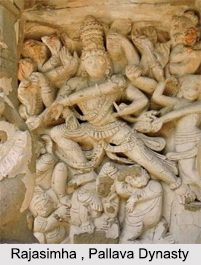 One of the most cherished kings of the Pallava dynasty, Narasimhavarman II fondly known as Rajasimha Pallava is remembered more than a thousand years later, for his supremacy and administration. His reign is known to be one of the most peaceful and secure times for its people. Rajasimha ruled from his capital-city of Kanchi over a vast kingdom bequeathed to him by his forefathers. Although he did wage a few battles, these were not in the league of those before or after, and his times are known for their undisturbed peace and prosperity.
One of the most cherished kings of the Pallava dynasty, Narasimhavarman II fondly known as Rajasimha Pallava is remembered more than a thousand years later, for his supremacy and administration. His reign is known to be one of the most peaceful and secure times for its people. Rajasimha ruled from his capital-city of Kanchi over a vast kingdom bequeathed to him by his forefathers. Although he did wage a few battles, these were not in the league of those before or after, and his times are known for their undisturbed peace and prosperity.
One of his inscriptions mentions that he ruled over a thousand islands, and this perhaps could be Lakshadweep. According to some scholars, Rajasimha provided some military assistance to the emperor of China who fought with the Arabs at that point of time.
Named after his great-grandfather, Narasimhavarman I (Mamalla), he shared his ancestor`s fervor for temple architecture. He initiated the concept of constructing structural temples out of stone. One among these was the famous Shore Temple at Mamallapuram and another Talagirishwara temple at Panamalai (near Viluppuram). But the grandest was the Kailasa-natha temple at Kanchipuram, built of sandstone.
Rajasimha Pallava`s court at Kanchi sheltered several scholars and is well known from the works of Dandin, the famous Sanskrit scholar that he was honoured at Rajasimha`s assembly.



















